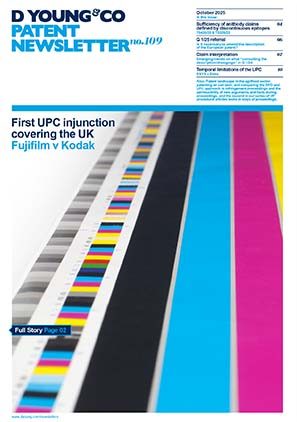Registration of transfers of rights and licences at the EPO
A number of changes have come into effect in relation to the registration of transfers of rights and licenses at the EPO. This article will set out two of the significant changes.
Use of electronic signatures
To record a transfer of ownership of a European patent or European patent application before the European Patent Office (EPO) a written document (such as an assignment) must be filed in order to evidence the transfer. The assignment document must be signed by all parties, that is, the assignor(s) and assignee(s). In recent years there have been a number of changes relating to the form of the signature on the assignment document.
2022: EPO accepts qualified electronic signatures on assignment documents
As reported in our May 2022 article, “Recording assignments with electronic signatures at the EPO”, following a Notice from the EPO published in Official Journal 2021, A86 on 22 October 2021, the EPO for a brief time additionally accepted some very specific forms of electronic signature. Specifically, for the purposes of recording a transfer of ownership, the EPO accepted assignment documents that had been signed using a qualified electronic signature as defined in EU Regulation No 910/2014 (also known as the eIDAS regulation). This regulation required a very particular form of qualified digital certificate to be used that was backed by a supervisory governmental body in the EU. Given these strict requirements, most of our clients continued to have assignment documents executed with handwritten signatures when recording transfers at the EPO.
Related article
“Recording assignments with electronic signatures at the EPO”, published 05 May 2022.
Read more2023: EPO stops electronic signatures on assignment documents
As discussed in our October 2023 article, “J 0005/23: EPO stops use of electronic signatures on assignment documents”, a decision from the Legal Board of Appeal (J 0005/23) on 04 September 2023 further slowed the increase in use of electronic signatures at the EPO. The decision of the Board of Appeal found that “signature” in the sense of the laws governing the requirements of an assignment means a handwritten signature or mark.
Related article
“J 0005/23: EPO stops use of electronic signatures on assignment documents”, published 02 October 2023.
Read more2024: EPO enables electronic signatures from 01 April 2024
A further development came to light on 29 February 2024. On the news section of the EPO website, an announcement was made with respect to changes regarding transfers and licences due to come into effect from 01 April 2024. In this announcement it was reported that electronic signatures will be enabled. The new concept will be applicable for the registration of transfers of rights and licences for European patent and unitary patent (UP) procedures. The EPO indicated that a broad range of signatures will be accepted. Specifically, contracts and declarations submitted as evidence to support requests for the registration of a transfer of rights and requests for the registration or cancellation of the registration of licences or other rights may be authenticated by:
- a handwritten signature
- a facsimile signature
- a text string signature
- a digital signature under the conditions specified by the EPO
A facsimile signature is an image reproduction of the handwritten signature and a text string signature is a string of characters between two forward slashes, for example: /D Young/. Regarding the digital signature, the EPO has relaxed the rules on these. Specifically, the EPO will accept digital signatures that use public key infrastructure (PKI) technology, including advanced and qualified electronic signatures within the meaning of the EU's eIDAS Regulation. It will also accept digital signatures that do not use PKI technology if they are filed electronically, are legible, are not infected with a computer virus and do not contain other malicious software.
This development marks an important milestone in the digitalisation and simplification of procedures at the EPO.
Entitlement to sign
In the past the EPO has been very strict with regard to a signatory on an assignment’s entitlement to sign the assignment on behalf of the assignor or assignee. It has not been uncommon for the EPO to request documentary evidence of the signatory's authority to sign. This has been seen whenever the signatory was not listed as, for example, a director, president or CEO of the company.
A further development which was published on the EPO website on 29 February 2024 was in relation to a further simplification of the registration processes relating to the registration of transfers of rights and licenses. Specifically, the EPO has changed its practice regarding examination of an individual's entitlement to sign on behalf of a company. Where a person is entitled to sign by virtue of their position within the company, this position still needs to be indicated. However, the EPO will no longer check the entitlement. Therefore, it is now down to the assignor(s) and assignee(s) to determine which parties are entitled to sign on behalf of the company, rather than this being assessed by the EPO based on the signatory’s title and whether it is one of a few select titles deemed allowable by the EPO.
This development is likely to further improve the efficiency of processes relating to the registration of transfers of rights and licenses.
Useful link
EPO website news release, 29 February 2024, “Transfers and licences: changes from 1 April 2024”: dycip.com/epo-electronicsignatures-apr2024

